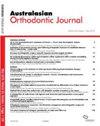Changing clear aligners every 10 days or 14 days ? A randomised controlled trial
IF 0.9
4区 医学
Q4 DENTISTRY, ORAL SURGERY & MEDICINE
引用次数: 1
Abstract
Abstract Objectives: To compare 10-day and 14-day change regimens to achieve orthodontic tooth movement (OTM) in patients wearing clear aligners and to determine their subsequent pain perception. Material and methods: A total of 175 clear aligner patients were assessed for eligibility. Seventy-two patients were randomly assigned to a 10-day group (N = 36) and a 14-day group (N = 36) and were instructed to change the appliances every 10 or 14 days, respectively. OTM efficacy and OTM variation between the actual and predicted OTM digital models measured by shell-to-shell deviation, as well as pain perception determined by a visual analog scale (VAS), were assessed at T0 (baseline, before the placement of the aligners), T1 (stage 8, after completion of aligners #8), and T2 (stage 16, after completion of aligners #16). Results: The 10-day and 14-day groups showed similar OTM efficacy at both T1 and T2 for all types of tooth movements (p > 0.09 for all) and similar OTM shell-to-shell deviation at T1 (p = 0.06) and T2 (p = 0.22). The two groups also had similar VAS scores of pain perception throughout the study (p > 0.05 for all). Conclusion: The 10-day and 14-day groups showed similar tooth movement and pain perception, suggesting that the clear aligners may be changed every 10 days without a significant compromise in the clinical efficacy of OTM and patient comfort. Trial registration: ChiCTR, ChiCTR-IOR-15007532. Registered 17 November 2015, https://www.chictr.org.cn/showproj.aspx?proj=12500每10天或14天更换一次牙齿矫正器?一项随机对照试验
摘要:目的:比较佩戴透明矫正器患者10天和14天更换方案实现正畸牙齿运动(OTM),并确定他们随后的疼痛感知。材料和方法:共对175例使用透明矫正器的患者进行资格评估。72例患者被随机分为10天组(N = 36)和14天组(N = 36),并被要求分别每10天和14天更换一次器具。在T0(基线,在放置矫正器之前)、T1(第8阶段,在完成8号矫正器之后)和T2(第16阶段,在完成16号矫正器之后)评估OTM疗效和实际和预测的OTM数字模型之间的OTM差异,以及由视觉模拟量表(VAS)确定的痛感。结果:10天组和14天组在T1和T2时对所有类型牙齿移动的OTM疗效相似(p < 0.05),在T1和T2时OTM壳间偏差相似(p = 0.06)和T2时OTM壳间偏差相似(p = 0.22)。两组在整个研究过程中疼痛感知的VAS评分也相似(p < 0.05)。结论:第10天组和第14天组的牙齿运动和痛觉相似,提示每10天更换一次透明矫正器,不会明显影响OTM的临床疗效和患者的舒适度。试验注册号:ChiCTR, ChiCTR- ior -15007532。2015年11月17日注册,https://www.chictr.org.cn/showproj.aspx?proj=12500
本文章由计算机程序翻译,如有差异,请以英文原文为准。
求助全文
约1分钟内获得全文
求助全文
来源期刊

Australasian Orthodontic Journal
Dentistry-Orthodontics
CiteScore
0.80
自引率
25.00%
发文量
24
期刊介绍:
The Australasian Orthodontic Journal (AOJ) is the official scientific publication of the Australian Society of Orthodontists.
Previously titled the Australian Orthodontic Journal, the name of the publication was changed in 2017 to provide the region with additional representation because of a substantial increase in the number of submitted overseas'' manuscripts. The volume and issue numbers continue in sequence and only the ISSN numbers have been updated.
The AOJ publishes original research papers, clinical reports, book reviews, abstracts from other journals, and other material which is of interest to orthodontists and is in the interest of their continuing education. It is published twice a year in November and May.
The AOJ is indexed and abstracted by Science Citation Index Expanded (SciSearch) and Journal Citation Reports/Science Edition.
 求助内容:
求助内容: 应助结果提醒方式:
应助结果提醒方式:


